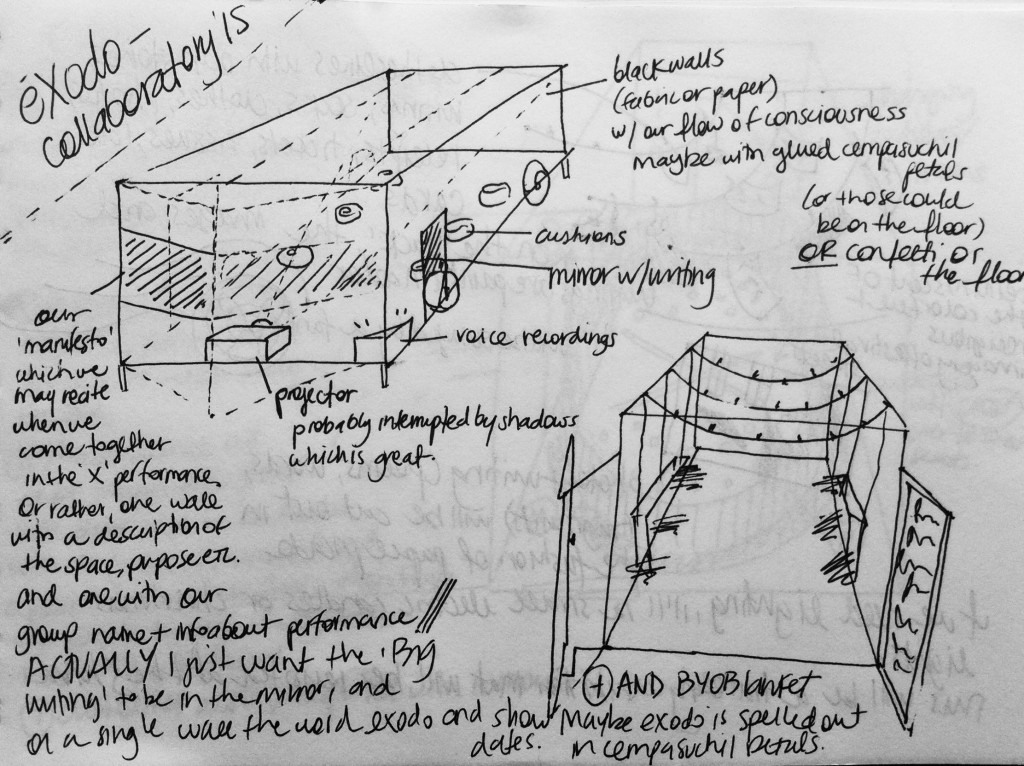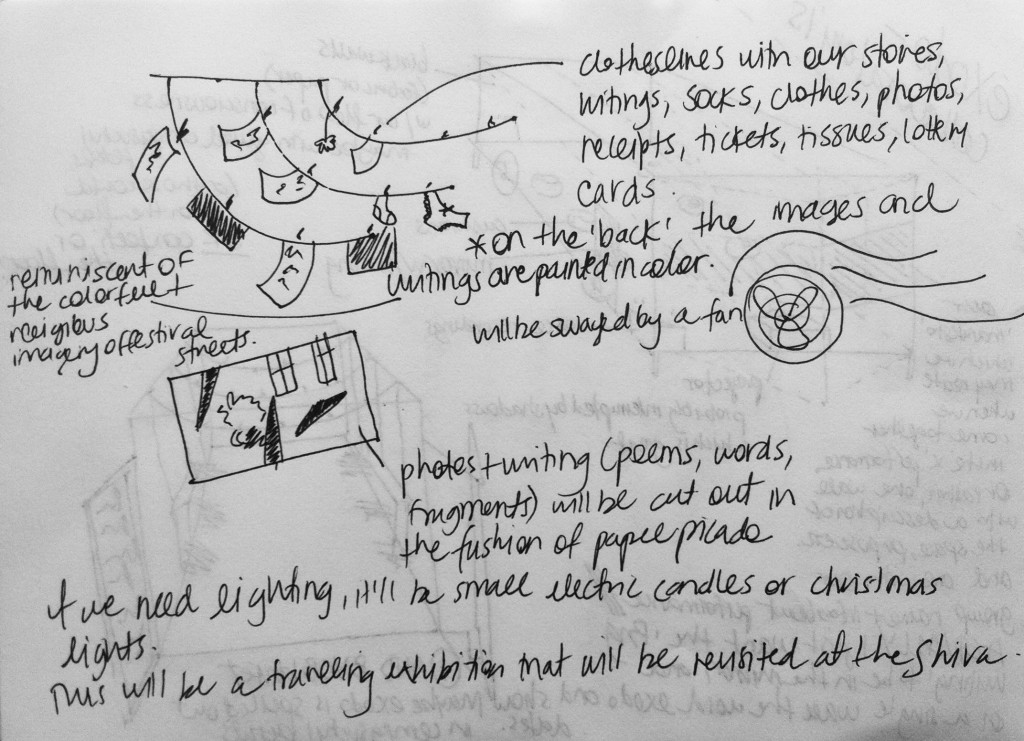All three student summer projects supported by CAAD are on the ground and doing the work! Here’s this week’s round of updates, including the first update from Healing Narratives. Enjoy!
SOUNDWALKING
In the Interlude: a group post from Jake Ellis, Alan Hagins, and Simaya Speed
The power of the interlude is commonly experienced, but saturated in the raucous and grungy temporal vectors of everyday life. By that I mean, our roles in life are never as clean-shaven as we’d like them to be. I drink my tea in a rush to a lecture and during the lecture. Am I conscientiously experiencing the calm and the ritual, or intently listening? Multi-tasking is a myth, they cry: Spend all of your attention on one thing, sequentially – and they love this mentality and gently caress it so long as what they want you to care about is first in the sequence. Whether multi-tasking is a myth or not, the virtual reality of easily accessible, immediate, downloadable, graphable, copy-and-paste information that touches us, when we touch the screen, compresses things. Things are no longer clean cut and drained of blood before we partake of/in them. I drink in my chamomile of vanilla, rose hips, and escapism along with the lecture because tasks and pockets of time have this enforced bond – sometimes what keeps you alive and what you live for reserve the same time slot. And you can make room for both if you move out those old cardboard boxes full of consciousness, the ones collecting dust. Zombie your way through tasks like a soulless ghost; one foot through the door, one foot out, but you’re still passing through walls so I guess that’s ok.
The pressure to NOT multi-task is an insipid continuation of the bring your own beer, and don’t step on the grass mentality. Do what you love and do it how you want, but don’t come over to this lawn if it makes your feet dirty. Don’t ruin the aesthetic of a sleek work ethic by having agency, by being in more places than one, at once. But don’t ruin the pattern of doing what’s already been done by having consciousness. Maybe multi-tasking doesn’t align with Taylorist notions of productivity. Boo hoo. Multi-tasking is what the world runs on, not Dunkin. Identities are built across time, in flux, in different spaces, a lapis lazuli made out of broken mirror shards – shards that used to give a full reflection but now are just pieces and the image they now give off is about how the light hits them.
I talk about multi-tasking because I think the interlude, as it performs most powerfully in the modern day, is revealed when its affiliation with multi-tasking is highlighted. We have things we must do, and things we must do in order to continue doing the things we must do. Our Circadian rhythm beats to the former; the pauses in between the beats symbolize the latter. But what happens when you speed up the tempo with expectations based upon virtual modality and digital mobility; when the pauses lose their sense of pause because the rhythm’s too fast? Who can speed up and slow down again that quickly? Who wants to?
No, multi-tasking arises when the things we must do in order to continue doing the things we must do are not given room to breathe – when they stop giving us room to breathe. There is no time for the consciousness we used to associate with these simple acts. They get digested into the expectations imposed onto us, we integrate them into “the routine”. The interlude exists as the temporal sideshow to what we must do; it occurs simultaneously with what we must do, but is not allocated the same focus, dedication, or immersion.
The interlude has been “built in” to everything else in a way that is seamless, but leaves echoing dissatisfaction. No time to pause, so I’ll take the pause with me in my travel mug.
This week, the group has focused on this idea of “taking the pause with me”. We’re toying with the idea of building interludes, proper pauses, into the sonic map – to embody the installation. These interlude spaces would be built for silences in the track, taking off headphones, changing audio equipment, recording oneself, having to make private choices about whether or not to record others or erase what others have recorded, etc. These interlude spaces would be built for interaction, a bare template of kinesthesia for thoughts, memories, euphorias, and pains that plague when people choose their adventures, discover for themselves, become aware of their agency and the potential that resets with every passing moment, destabilize their “preconceived notions” and these hidden layers of connotation. The goal is to let the individual experiencing the installation fully realize the pause, embrace the pause, drown in the pause, absorb the spirit of the pause with liberation and unabashed exploration of the self as it relates to a variety of familiar subjects (which will likely be fine arts and technological in medium), and then take the pause with them. This isn’t gonna be a Supersize Me grab-n-go type of pause we dry-swallow to keep the tape rolling; rather, it is a pause you can build for yourself, and a space you can reserve for yourself in a unique reality that you choose to dissociate from or connect with other unique realities and perspectives.
Exodo
in making choices, in scrapping ideas, in leaning towards what feels and works best these are some unearthed skeletons from a (or multiple) closets. they’re full of space.
Healing Narratives
July 10, 2015 ~ Hudson Valley Hospice
Terry couldn’t have been more inviting. Her long, pinstripe-gray hair shone in the same way her smile and humility did. We sat down around an oval table with our complimentary coffee cups and began the interview.
She talked about her role as a music therapist in the hospice: how she helped people based on personal needs, whether they be in critical need of musical healing or simply wanting a nice melodic background to fill the sonic gaps in their rooms. She has been working at the hospice for twelve years, and was one of the essential hands in founding this branch of therapy at the Hudson Valley Hospice. Her previous work as a musician informs her practice and imbues it with specificity and refinement, so she can appropriately adapt to any environment she is confronted with. Although music has always been her passion, music therapy has provided a space where her passion can reach beyond aesthetic pleasure into a curative and healing realm.
She talked lovingly of her interns and their growth throughout their internship at the hospice. It was their last day as interns, and you could see the pride in Terry’s eyes. She boasted about their adaptability to this new and intense environment. Some of them had well-developed music backgrounds without fully developed interpersonal skills, while others had humanitarian backgrounds, but needed to work on their musicianship.
We talked about bridges. Music acts as a bridge between beings, one that can transcend temporal boundaries both internally and externally. It bridges youth with the elderly, memory with present experience, mind with body. Through music, people are able to access faculties that were previously inaccessible. Terry told us of a woman who repeated to herself over and over: “I am nothing. I am nothing. I am nothing. I am nothing.” When music was turned on, she would temporarily step out of her state to sing the song, and when it would turn off, she would go right back to “I am nothing.” Music opens up different neurological processing pathways. Whereas someone in hospice may not be able to speak because it requires the active formation of word combinations, they can easily sing a song that has been embedded in their music memory, because it does not necessitate the involved process of word creation. Terry helps to facilitate these bridges, by opening up pathways that may have previously seemed gated.
An elderly man, whose condition was quickly declining, was found dead in a forest outside of his care facility. He had been a patient of Terry’s, who planned on visiting him in the next few days. Everyone was blind-sided by his random death, and Terry took it especially hard. How are we to reconcile ourselves to thoughts of untimely and unfair death?
That man had a sister who died not too long before him. There are traditions that believe people are summoned to die in certain places, specifically in nature. It brings Terry solace to think that his sister may have wanted him to die under the stars, away from hospital beds and sterile machines. Although we cannot be sure of the powers of extra-human forms to guide us, it may give us a slight feeling of comfort to believe in their guidance, which is all we can hope for in situations like these.



